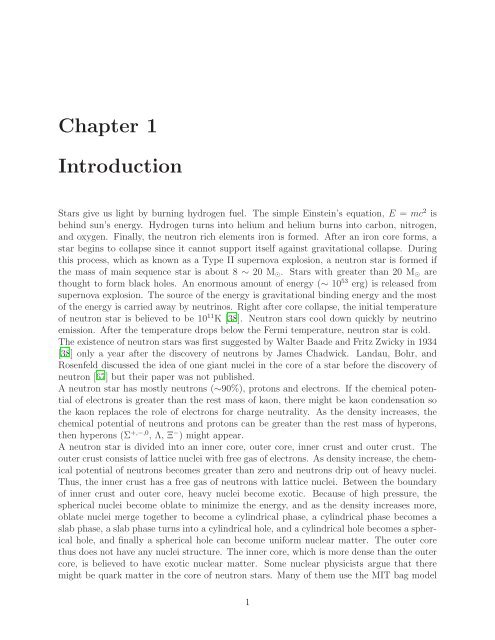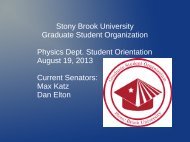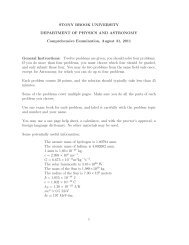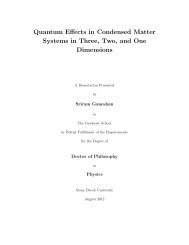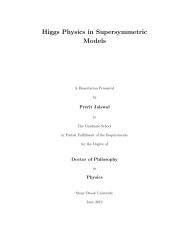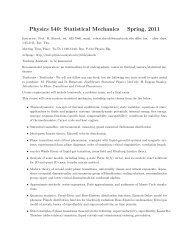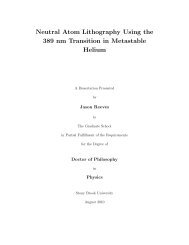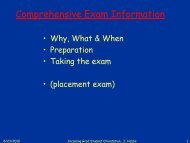Theory of Nuclear Matter for Neutron Stars and ... - Graduate Physics
Theory of Nuclear Matter for Neutron Stars and ... - Graduate Physics
Theory of Nuclear Matter for Neutron Stars and ... - Graduate Physics
Create successful ePaper yourself
Turn your PDF publications into a flip-book with our unique Google optimized e-Paper software.
Chapter 1Introduction<strong>Stars</strong> give us light by burning hydrogen fuel. The simple Einstein’s equation, E = mc 2 isbehind sun’s energy. Hydrogen turns into helium <strong>and</strong> helium burns into carbon, nitrogen,<strong>and</strong> oxygen. Finally, the neutron rich elements iron is <strong>for</strong>med. After an iron core <strong>for</strong>ms, astar begins to collapse since it cannot support itself against gravitational collapse. Duringthis process, which as known as a Type II supernova explosion, a neutron star is <strong>for</strong>med ifthe mass <strong>of</strong> main sequence star is about 8 ∼ 20 M ⊙ . <strong>Stars</strong> with greater than 20 M ⊙ arethought to <strong>for</strong>m black holes. An enormous amount <strong>of</strong> energy (∼ 10 53 erg) is released fromsupernova explosion. The source <strong>of</strong> the energy is gravitational binding energy <strong>and</strong> the most<strong>of</strong> the energy is carried away by neutrinos. Right after core collapse, the initial temperature<strong>of</strong> neutron star is believed to be 10 11 K [38]. <strong>Neutron</strong> stars cool down quickly by neutrinoemission. After the temperature drops below the Fermi temperature, neutron star is cold.The existence <strong>of</strong> neutron stars was first suggested by Walter Baade <strong>and</strong> Fritz Zwicky in 1934[38] only a year after the discovery <strong>of</strong> neutrons by James Chadwick. L<strong>and</strong>au, Bohr, <strong>and</strong>Rosenfeld discussed the idea <strong>of</strong> one giant nuclei in the core <strong>of</strong> a star be<strong>for</strong>e the discovery <strong>of</strong>neutron [67] but their paper was not published.A neutron star has mostly neutrons (∼90%), protons <strong>and</strong> electrons. If the chemical potential<strong>of</strong> electrons is greater than the rest mass <strong>of</strong> kaon, there might be kaon condensation sothe kaon replaces the role <strong>of</strong> electrons <strong>for</strong> charge neutrality. As the density increases, thechemical potential <strong>of</strong> neutrons <strong>and</strong> protons can be greater than the rest mass <strong>of</strong> hyperons,then hyperons (Σ +,−,0 , Λ, Ξ − ) might appear.A neutron star is divided into an inner core, outer core, inner crust <strong>and</strong> outer crust. Theouter crust consists <strong>of</strong> lattice nuclei with free gas <strong>of</strong> electrons. As density increase, the chemicalpotential <strong>of</strong> neutrons becomes greater than zero <strong>and</strong> neutrons drip out <strong>of</strong> heavy nuclei.Thus, the inner crust has a free gas <strong>of</strong> neutrons with lattice nuclei. Between the boundary<strong>of</strong> inner crust <strong>and</strong> outer core, heavy nuclei become exotic. Because <strong>of</strong> high pressure, thespherical nuclei become oblate to minimize the energy, <strong>and</strong> as the density increases more,oblate nuclei merge together to become a cylindrical phase, a cylindrical phase becomes aslab phase, a slab phase turns into a cylindrical hole, <strong>and</strong> a cylindrical hole becomes a sphericalhole, <strong>and</strong> finally a spherical hole can become uni<strong>for</strong>m nuclear matter. The outer corethus does not have any nuclei structure. The inner core, which is more dense than the outercore, is believed to have exotic nuclear matter. Some nuclear physicists argue that theremight be quark matter in the core <strong>of</strong> neutron stars. Many <strong>of</strong> them use the MIT bag model1


